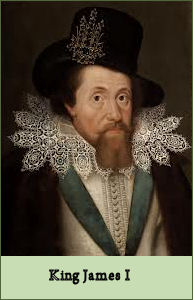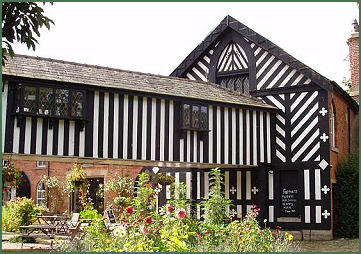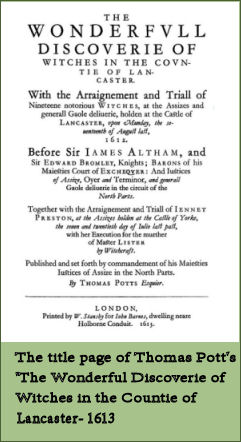The Samlesbury Witches
Background to the Witch Trials
 King James I, the first Stuart king of England, succeeded to the throne on the death of his cousin Elizabeth in 1603. James was a firm believer in witchcraft. By the early 1590s, when King of Scotland, James, after a visit to Denmark, followed the 1590 trial of the North Berwick witches with interest, the North Berwick witches involved in the trial were accused of using witchcraft to stir up a storm against the ship that carried James and his bride, Anne of Denmark back to Scotland. He was also the author of a book on witchcraft entitled Daemonologie. . In 1604, the year after James's accession to the throne of England, a new witchcraft law was enacted, "An Act against Conjuration, Witchcraft and dealing with evil and wicked spirits", imposing the death penalty for causing harm by witchcraft.
King James I, the first Stuart king of England, succeeded to the throne on the death of his cousin Elizabeth in 1603. James was a firm believer in witchcraft. By the early 1590s, when King of Scotland, James, after a visit to Denmark, followed the 1590 trial of the North Berwick witches with interest, the North Berwick witches involved in the trial were accused of using witchcraft to stir up a storm against the ship that carried James and his bride, Anne of Denmark back to Scotland. He was also the author of a book on witchcraft entitled Daemonologie. . In 1604, the year after James's accession to the throne of England, a new witchcraft law was enacted, "An Act against Conjuration, Witchcraft and dealing with evil and wicked spirits", imposing the death penalty for causing harm by witchcraft.
The women accused of witchcraft all lived in the county of Lancashire, considered a lawless region at the time and one in which many refused to abandon their Catholic religion. Following the death of the staunchly Cathoilc Queen Mary I and the accession to the throne of her Protestant half-sister Elizabeth in 1558, Catholic priests who refused to abandon their faith continued to celebrate the mass in secret. In early 1612, the year of the trials, each justice of the peace (JP) in Lancashire was ordered to compile a list of the recusants in their area—those who refused to attend the services of the Church of England, which was deemed a criminal offence at that time.
The Southworth Famiy
 The Southworth family of Samlesbury Hall, ( pictured left) had been split by their religious beliefs. Sir John Southworth, the head of the family, had been arrested a number of times for his refusal to abandon his Catholic beliefs. His eldest son, John, had converted to the Church of England, in response to which he had been disinherited by his father, the rest of the family remained Catholic.
The Southworth family of Samlesbury Hall, ( pictured left) had been split by their religious beliefs. Sir John Southworth, the head of the family, had been arrested a number of times for his refusal to abandon his Catholic beliefs. His eldest son, John, had converted to the Church of England, in response to which he had been disinherited by his father, the rest of the family remained Catholic.
One of the women accused of witchcraft, Jane Southworth, was the widow of the disinherited son, John. Relations between John and his father appear to have been embittered, according to John Singleton, Sir John the elder, refused even to pass his son's house if it could be avoided. At the time of the trials Jane Southworth had been widowed for but a few months and was the mother of seven children.
The Trials
 Following the arrest and questioning of the Pendle Witches in March 1612 by the magistrate Roger Nowell, on 15th April 1612 JP Robert Holden began investigations in his own area of Samlesbury, a village in the Ribble Valley. This resulted in eight people being committed to Lancaster Assizes, for investigation, three of whom – Jane Southworth, Jennet Bierley, and Ellen Bierley – were accused of practising witchcraft on fourteen year old Grace Sowerbutts, the grand-daughter of Jennet and Ellen's niece. The three unfortunate women were taken to Lancaster Castle and held in the same dungeon below the Well Tower as the Pendle Witches.
Following the arrest and questioning of the Pendle Witches in March 1612 by the magistrate Roger Nowell, on 15th April 1612 JP Robert Holden began investigations in his own area of Samlesbury, a village in the Ribble Valley. This resulted in eight people being committed to Lancaster Assizes, for investigation, three of whom – Jane Southworth, Jennet Bierley, and Ellen Bierley – were accused of practising witchcraft on fourteen year old Grace Sowerbutts, the grand-daughter of Jennet and Ellen's niece. The three unfortunate women were taken to Lancaster Castle and held in the same dungeon below the Well Tower as the Pendle Witches.
The trial of the Salmesbury witches took place on 19 August 1612, the presiding judge was Sir Edward Bromley. Prior to the trial, Bromley ordered the release of five of the eight defendants from Samlesbury, with a warning about their future conduct. The remaining three , Jane Southworth, Jennet Bierley, and Ellen Bierley, were accused of using "diverse devillish and wicked Arts, called Witchcrafts, Inchauntments, Charmes, and Sorceries, in and upon one Grace Sowerbutts", they all pleaded not guiltyto the charge. The fourteen year old Grace was the chief prosecution witness.
 The evidence of Grace was heard first. In her statement to the authorities she claimed that both her grandmother and aunt, Jennet and Ellen Bierley, were able to transform themselves into dogs and that they had "haunted and vexed her" for years. She further alleged that they had transported her to the top of a hayrick by her hair, and on another occasion had tried to persuade her to drown herself. According to Grace, her relatives had taken her to the home of Thomas Walshman and his wife, from whom they had stolen a baby to suck its blood. Grace claimed that the child died the following night, and that after its burial at Samlesbury Church Ellen and Jennet dug up the body and took it home, where they cooked and ate some of it and used the rest to make an ointment that enabled them to change themselves into other shapes.
The evidence of Grace was heard first. In her statement to the authorities she claimed that both her grandmother and aunt, Jennet and Ellen Bierley, were able to transform themselves into dogs and that they had "haunted and vexed her" for years. She further alleged that they had transported her to the top of a hayrick by her hair, and on another occasion had tried to persuade her to drown herself. According to Grace, her relatives had taken her to the home of Thomas Walshman and his wife, from whom they had stolen a baby to suck its blood. Grace claimed that the child died the following night, and that after its burial at Samlesbury Church Ellen and Jennet dug up the body and took it home, where they cooked and ate some of it and used the rest to make an ointment that enabled them to change themselves into other shapes.
Grace further alleged that her grandmother and aunt, with Jane Southworth, attended sabbats held every Thursday and Sunday night at Red Bank, on the north shore of the River Ribble. At those secret meetings they met with "foure black things, going upright, and yet not like men in the face", with whom they ate, danced, and had sex. The evidence of Thomas Walshman, the father of the baby allegedly killed, was hear next. He confirmed that his child had died of unknown causes at about one year old. He added that Grace Sowerbutts was discovered lying as if dead in his father's barn on about 15 April, and did not recover until the following day. Two other witnesses, John Singleton and William Alker, confirmed that Sir John Southworth, Jane Southworth's father-in-law, had been reluctant to pass the house where his son lived, as he believed Jane to be an "evil woman, and a Witch".
Thomas Potts, the clerk to the Lancaster Assizes, reported that after hearing the evidence many of those present in court were persuaded of the three women's guilt. On being questioned by the judge what answer they could make to the charges laid against them, the three defendants "humbly fell upon their knees with weeping teares", and "desired him [Bromley] for Gods cause to examine Grace Sowerbutts". Immediately, Potts goes on to record "the countenance of this Grace Sowerbutts changed"; the witnesses "began to quarrel and accuse one another", and eventually admitted that Grace had been coached in her avccount of the affair by a Catholic priest they called Thompson. Bromley then committed the girl to be examined by two JPs, William Leigh and Edward Chisnal. Under questioning Grace admitted that her story was untrue, and added that she had been coached what to say by Jane Southworth's uncle, Christopher Southworth aka Thompson, a Jesuit priest who was in hiding in the Samlesbury area. Southworth was the chaplain at Samlesbury Hall. After the statements had been read out in court Bromley ordered the jury to find the defendants not guilty.
